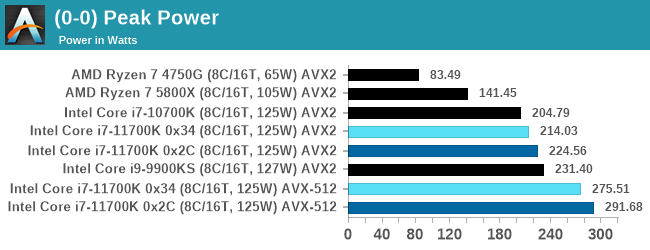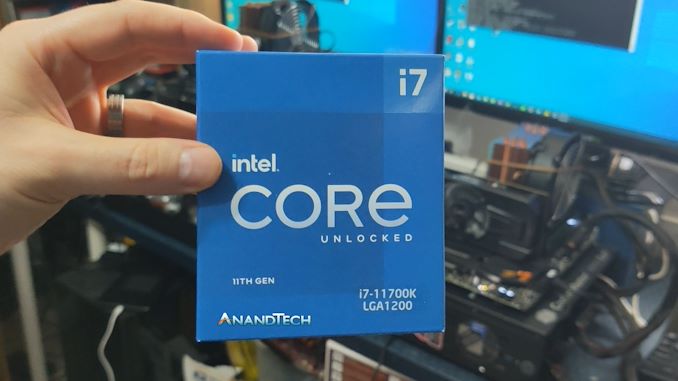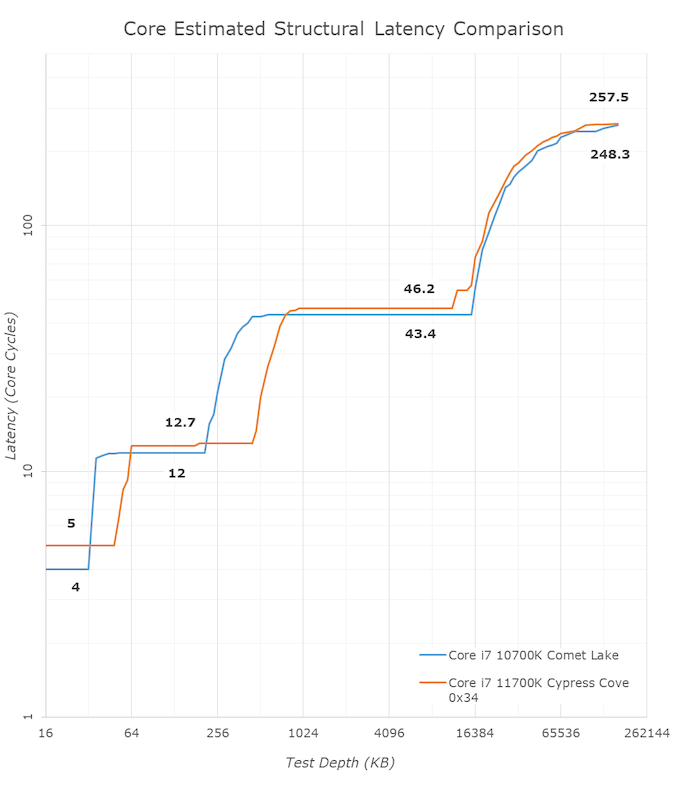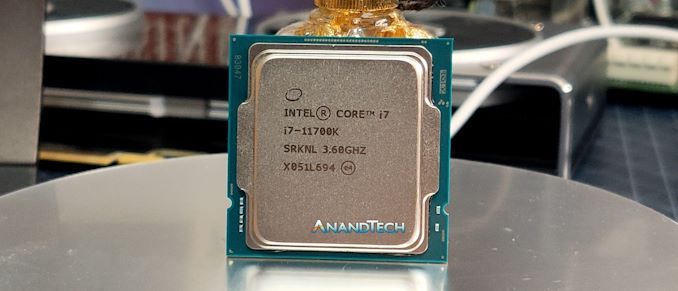Intel Core i7-11700K Review: Blasting Off with Rocket Lake
by Dr. Ian Cutress on March 5, 2021 4:30 PM EST- Posted in
- CPUs
- Intel
- 14nm
- Xe-LP
- Rocket Lake
- Cypress Cove
- i7-11700K
Conclusion: The War of Attrition
(These numbers have been updated with the later 0x34 microcode)
Intel’s desktop product teams have had their hands in a bind for a while. The goal was always to migrate from 14nm to 10nm when the intersection of performance, cost, and power hit the sweet spot. This was originally expected to happen after 2017, with the launch after Kaby Lake, but we are here in 2021 and this still hasn’t happened. Intel’s 10nm manufacturing process is unable to scale to the right level of frequency, power, and cost that is needed for an effective desktop processor.
Now Intel is full of smart people – alongside the manufacturing team, the internal microarchitecture teams building the next generation cores would have already been 3-5 years ahead in their design cycle, waiting to deploy the best ideas when the manufacturing was ready. However, with a plug in the pipeline and no way to easily patch it, Intel had to decide what to do in a worst case scenario – what if 10nm is never ready?
The first part of that answer is in our hands today. Despite not being designed for 14nm, Intel took its 10nm Sunny Cove core design (and Xe integrated graphics), and rebuilt it from the ground up. This sounds arduous – all the solutions to get things working in 10nm need to be rethought, and new issues with timing and signal integrity have to be solved. It wasn’t designed for 14nm, and to signify its difference, it was called Cypress Cove. These engineers are no doubt frustrated that they had core designs on the table, ready to go on 10nm, but they had to re-draw them in a different style where they are bigger and more power hungry, just to get something out of the door. That different style is Rocket Lake, and specifically the Core i7-11700K we have tested today.
Improvements for Desktop, Sort Of
Rocket Lake brings to the table a big core design with new features such as AVX-512 and PCIe 4.0. The core is so big that in order to keep die size, yield, and costs similar to the previous generation, the final design only has eight cores rather than ten. This would appear to be a 20% regression in absolute performance, however Intel is promoting a +19% average performance gain, evening it all out, while also providing the new features listed above. That +19% also should apply to single thread situations, enabling faster single user response time.
To validate Intel’s claims here, we run our industry standard benchmarks, such as SPEC, and compare the i7-10700K to the i7-11700K. Though this testing, we can confirm that Intel is correct on that +19% claim, however that isn’t an overall performance uplift and there’s a big asterisk next to that number.
All workloads at their core, even when browsing the web or word processing, can be split into integer (whole numbers, most workloads) and floating point (numbers with decimal places, workloads with math). In our testing, we saw the following:
- Single thread floating point: +22%
- Multi-thread floating point: +16.2%
Sounds great, right?
- Single thread integer: +18.5%
- Multi-thread integer: +5.8%
Oh. While Intel’s claim of +19% is technically correct, it only seems to apply to math-heavy workloads or single thread integer workloads. The benefits of non math-based throughput are still better than average, but only at 5.8% for multithreaded. Very rarely do Intel’s big claims come with an easily identifiable asterisk.
When we look at our real-world data, in almost every benchmark the 11700K either matches or beats the 10700K, and showcases the IPC gain in tests like Dolphin, Blender, POV-Ray, Agisoft, Handbrake, web tests, and obviously SPECfp. It scores a big win in our 3DPM AVX test, because it has AVX-512 and none of the other CPUs do.
A Comment on Gaming
Users looking at our gaming results will undoubtedly be disappointed. The improvements Intel has made to its processor seem to do very little in our gaming tests, and in a lot of cases, we see performance regressions rather than improvements. If Intel is promoting +19% IPC, then why is gaming not seeing similar jumps?
Normally with gaming we might look to the structural latency comparison to see where some uplifts might come.
The biggest change in the cache hierarchy is in the L3 cache, which is now ~45-46 cycles rather than 42-43 cycles. When we originally tested this with the 0x2C microcode it was 51 cycles, but Intel has implemented updates to reduce this to around 45-46 cycles, which improves gaming performance a little. This is still a slight regression, and we’re seeing the core-to-core latency (regardless of microcode) still show 28-30 nanosecond latencies on most cores, rather than 18-24 as observed on Comet Lake. We expected some regressions from Ice Lake/Sunny Cove with the backported core – 51 cycles for the L3 was considered a lot, but reducing that to 45-46 cycles is still a slight regression, but more in line with what we expected. Overall, there is an effective latency decrease from having larger caches, but this hasn't translated into gaming performance along with the increase in IPC.
But Margins, Power, and Temperature
Moving into this review, users that have followed Intel’s desktop platform know that sustained power modes on the high-core count models are a lot higher than the number on the box suggests. This isn’t just limited to the overclockable processors, like in our i9-10850K review where we saw 260 W, but even the i7-10700 rated at 65 W would push 200 W, especially in motherboards that ignored recommended turbo limits (which is practically every consumer gaming motherboard).
The migration of Sunny Cove cores, already known for being power hungry, onto an older process node, and then bundling AVX-512 in the mix, has had a number of enthusiasts concerned for how Intel would approach power consumption. Based on our testing today, the simple answer is to offer a blessing to the deity of your choice for a good CPU. Our Core i7-11700K is rated at 125 W. But in practice for a mild AVX2 workload we saw 225 W of power consumption and a temperature of 81ºC, while a general workload was around 130-155 W at 60ºC.

The danger is that during our testing, the power peaked at an eye-catching 292 W on one of our tests systems. This was during an all-core AVX-512 workload, automatically set at 4.6 GHz, and the CPU hit 104ºC momentarily. A second motherboard, running new firmware, only peaked at 276 W, running at 4.4-4.6 GHz, but still saw 103ºC before reducing in power to 225 W.
For the first motherboard on the 0x2C microcode, there’s no indication that the frequency reduced when hitting this temperature, and our cooler is easily sufficient for the thermal load, which means that on some level we might be hitting the thermal density limits of wide mathematics processing on Intel’s 14nm. In order to keep temperatures down, new cooling methods have to be used, regardless of motherboard or microcode.
I noted that Intel has reduced the air gap inside the CPU package, with the whole z-height reduced from 4.48 mm to 4.36 mm. It’s a small change, meaning less material for thermal energy to transfer through, improving cooling.
Users looking to overclock on these processors are going to have to implement a strong AVX-512 offset here.
A Rock(et) and A Hard Place, But The Only Option Available
Rocket Lake is the product of an idea to backport a design, and ensures that the popular market segment of consumer processors is closer to the leading edge of Intel’s design, despite the unavailability of Intel’s latest process node to desktop-class hardware.
Going forward, Intel has (in not so many words) committed to a less rigid philosophy than the past – use the right design on the right process node, rather than tying the two together. Rocket Lake is arguably the first product coming from that philosophy, despite being a later part that came after core was designed in the first place. But Intel will measure its success as an initial yard stick to similar endeavors in the future. And it will succeed, for reasons external to Intel.
Our results clearly show that Intel’s performance, while substantial, still trails its main competitor, AMD. In a core-for-core comparison, Intel is slightly slower and a lot more inefficient. The smart money would be to get the AMD processor. However, due to high demand and prioritizing commercial and enterprise contracts, the only parts readily available on retail shelves right now are from Intel. Any user looking to buy or build a PC today has to dodge, duck, dip, dive and dodge their way to find one for sale, and also hope that it is not at a vastly inflated price. The less stressful solution would be to buy Intel, and use Intel’s latest platform in Rocket Lake.
Normally this is the point where I’d conclude with a comment on what to recommend. But the clear answer during this chip crunch is to buy the processor you can find at a reasonable price. We don’t have official pricing on Rocket Lake just yet, but if a retailer was happy to sell units before the official launch, then perhaps there will be sufficient number out there to go around.
Official details of Rocket Lake will be posted when our NDA on that information expires. Official retail of Rocket Lake will commence on March 30th.













541 Comments
View All Comments
zzzxtreme - Sunday, March 7, 2021 - link
I wished you would have tested the XE graphicsFman4 - Monday, March 8, 2021 - link
Am I the only one find that OP plugged 4 RAMs on an X570 ITX motherboard?Fman4 - Monday, March 8, 2021 - link
@Dr. Ian Cutresszodiacfml - Monday, March 8, 2021 - link
bored. just here to say this is unsurprising though this strongly reminds me of the time where AMD is releasing new, well designed CPUs but two process node generations behind intel. I think AMD was 32nm and 28nm while Intel is 22 and 14nm. most comments were really harsh with AMD but I reasoned that it is simply due to the manufacturing superiority of Intelblppt - Monday, March 8, 2021 - link
Bulldozer and Piledriver are not the examples I would put up for "well designed".GeoffreyA - Tuesday, March 9, 2021 - link
Still, within that mess, AMD did a pretty good job raising Bulldozer's IPC and cutting down its power each generation. But the foundation being fatally flawed, it was hopeless. I believe it taught them a lot about cutting power and so on, and when they poured that into Zen, we saw the result. Bulldozer was a fantastic training ground, if one looks at it humorously.Oxford Guy - Tuesday, March 9, 2021 - link
No, AMD did an extremely poor job.Firstly, Bulldozer had worse IPC than Phenom. No engineers with brains release a CPU to replace the entire line while giving it worse IPC. The trap of going for high clocks was a lesson shown to the entire industry via Netburst. AMD's engineers knew all about it, yet someone at the company decided to try Netburst 2.0.
Secondly, AMD was so sloppy and lazy that Piledriver shipped with a performance regression in AVX. It was worse to use AVX than to not use it. How incredibly incompetent can the company have been? It doesn't take a high IQ to understand that one doesn't ship broken AVX.
AMD then refused to replace Piledriver until Zen came out. It tinkered half-heartedly with APU rubbish and focused on pushing junk like Jaguar.
While it's true that the extreme failure of AMD (the construction core line) is due, to a large degree, to Intel abusing its monopoly to starve AMD of customers and cash — cash it needed to do R&D, one does not release a new chip with worse IPC and then very shortly after break AVX and refuse to stop feeding that junk to customers for many years. Just tinkering with Phenom would have been better (Phenom 3).
As for the foundation claim... we have no idea how well the CMT concept could have worked out with competent engineering. Remember, they literally broke AVX in the Piledriver revision that was supposed to fix Bulldozer enough to make it sellable. Operations caching could have been stronger. The L3 cache was almost as slow as main memory. The RAM controller was weak, just like Phenom's. Etc.
We paid for Intel's monopoly and we're still paying today. Only its monopoly and the lack of adequate competition is enabling the company to be so profitable despite failing so badly. Relying on two companies (or one 1/2, when it comes to R&D money ratio and other factors) to deliver adequate competition doesn't work.
Google and Microsoft = Google owns the clearnet. Apparently, they have some sort of cooperation agreement which helps to explain why Bing has such a tiny index and such a poor-quality search.
TSMC and Samsung = Can't meet demand.
AMD and Nvidia = Nvidia keeps breaking profit records while utterly failing to meet demand. Both companies refuse to stop making their cards attractive for mining and have for a long long time. AMD refused to adequately compete beyond the lower midrange (Polaris forever, or you can buy a 'console'!) for a long time, leaving us to pay through the nose for Nvidia's prices. AMD literally competes against the PC market by pushing the console scam. Consoles are gaming PCs in disguise and they're parasitic in multiple ways, including in terms of wafer allocations. AMD's many many years of refusal to compete with Nvidia beyond the Polaris price point caused so much pent-up demand and now the company can enjoy the artificially high price points from that. It let Nvidia keep raising prices to get consumers used to that. Now that it has finally been forced to improve the 'consoles' beyond the garbage-tier Jaguar CPU it has to offer a bit more value to the PC gaming market. And so, after all these years, we have something decent that one can't buy. I can go on about this so-called competition but why bother. People will go to the most extravagant lengths to excuse the problem of lack of adequate competition — like the person who recently said it's easier to create Google's empire from scratch than it is to make a competitive GPU and sell it as a third GPU company.
There are plenty of other areas in tech with inadequate competition, too.
blppt - Tuesday, March 9, 2021 - link
"AMD then refused to replace Piledriver until Zen came out. It tinkered half-heartedly with APU rubbish and focused on pushing junk like Jaguar."To be fair, AMD had put a LOT of time, money and effort into Bulldozer/Piledriver, and were never a company with bottomless wells of cash to toss an architecture out immediately. Plus, Zen took a long time to design and finalize---thankfully, they made literally ALL the right moves in designing it, including hiring the brilliant Jim Keller.
I think if Zen had been another BD like failure, that would have been the almost the end of AMD in the cpu market (leaving them basically as ATI was) The consoles likely would have gone with Intel or ARM for their next iteration. AMD once again spent tons of money that they don't have as disposable income in designing Zen. Two failures in a row would have been disastrous.
Heck, the consoles might go with their own custom ARM design for PS6/Xbox(whatever) anyways.
GeoffreyA - Wednesday, March 10, 2021 - link
blppt. Agreed, that would have been the end of AMD.Oxford Guy - Wednesday, March 10, 2021 - link
AMD did not put a lot of resources into fixing Bulldozer.It shipped Piledriver with broken AVX and never bothered to replace Piledriver on the desktop until Zen.
Inexcusable. It shipped Steamroller and Excavator in cost-cut mode, cutting cores, cutting clocks, cutting the socket standards, and cutting cache. It used a dense library to save money by keeping the die small and used the inferior 28nm bulk process.
Pathetic in basically every respect.